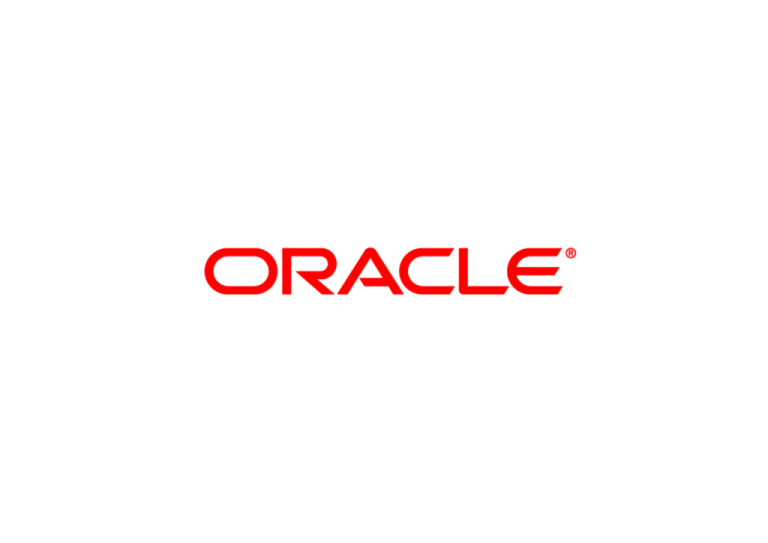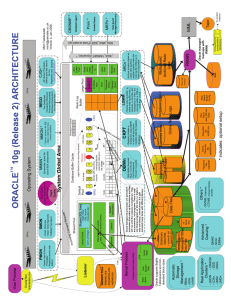FRI okt 2006
advertisement

Robert Korošec Principal Sales Consultant Oracle Quick-Start to the Oracle DB Architecture Oracle Server Architecture An Oracle server: • Is a database management system that provides an open, comprehensive, integrated approach to information management • Consists of an Oracle instance and an Oracle database Oracle Server Oracle RDBMS Architecture Oracle Instance SMON SNPn LCKn Snnn RECO Dnnn PMON Pnnn SGA DBWR Shared Pool Database Buffer Cache Redo Log Buffer LGWR CKPT ARCH Server Processes User Processes Oracle Database Parameter File Control Files Datafiles Redo Log Files Database Files • • • • • Parameter Files Control Files Data Files Redo Log Files Undo Data Files PFILE Example # Initialization Parameter File: initdb01.ora db_name = db01 instance_name = db01 control_files = ( /u03/oradata/db01/control01db01.ctl, /u03/oradata/db01/control02db01.ctl) db_block_size = 4096 db_block_buffers = 500 shared_pool_size = 31457280 # 30M Shared Pool db_files = 1024 background_dump_dest user_dump_dest core_dump_dest undo_management undo_tablespace . . . = = = = = /u05/oracle10g/admin/db01/bdump /u05/oracle10g/admin/db01/udump /u05/oracle10g/admin/db01/cdump auto undtbs SPFILE spfileSID.ora • Binary file with the ability to make changes persistent across shutdown and startup • Maintained by the Oracle server • Records parameter value changes made with the ALTER SYSTEM command • Can specify whether the change being made is temporary or persistent • Values can be deleted or reset to allow an instance to revert to the default value Control File The control file is a binary file that defines the current state of the physical database.. • Is read at MOUNT stage • Is required to operate • Is linked to a single database Database • Should be multiplexed Control files • Maintains integrity of database Database Files • • • Parameter Files Control Files Data Files Tablespaces • Data Types • Tables • Indexes • • • Redo Log Files Undo Data Files Resizing a Tablespace • Add a data file • Change the size of a data file: • Automatically • Manually Tablespace APP_DATA 100M 100M 200M 100M app_data_01.dbf app_data_02.dbf app_data_03.dbf Classification of Indexes • Logical • • • • Single column or concatenated Unique or nonunique Function Based Domain Based • Physical • Partitioned or nonpartitioned • B-tree • Normal or reverse key • Bitmap Handout Handout B-Tree Index Index entry Root Branch Index entry header Leaf Key column length Key column value ROWID Handout Handout Bitmap Index Table File 3 Block 10 Block 11 Block 12 Index start end key ROWID ROWID bitmap <Blue, 10.0.3, 12.8.3, 1000100100010010100> <Green, 10.0.3, 12.8.3, 0001010000100100000> <Red, 10.0.3, 12.8.3, 0100000011000001001> <Yellow, 10.0.3, 12.8.3, 0010001000001000010> Comparing B-Tree and Bitmap Indexes B-tree Bitmap Suitable for high-cardinality Suitable for low-cardinality columns columns Updates on keys relatively inexpensive Updates to key columns very expensive Inefficient for queries using OR predicates Efficient for queries using OR predicates Useful for OLTP Useful for data warehousing Handout Handout Using Redo Log Files Redo log files record all changes made to data and provide a recovery mechanism from a system or media failure. • Redo log files are organized into groups. • An Oracle database requires at least two groups. • Each redo log within a group is Database called a member. Redo log files How Redo Logs Work • Redo logs are used in a cyclic fashion. • When a redo log file is full, LGWR will move to the next log group. • This is called a log switch • Checkpoint operation also occurs • Information is written to the control file Archived Redo Log Files Filled online redo log files can be archived. • Two advantages exist to archiving redo logs: • Recovery: A database backup, together with online and archived redo log files can guarantee recovery of all committed transactions. • Backup: Can be performed while the database is open. • By default a database is created in NOARCHIVELOG mode. Managing Undo Data Overview • Two methods for managing undo data exists • Automatic Undo Management • Manual Undo Management • The term undo replaces what was known in previous versions of Oracle as rollback Handout Handout Undo Segment Old image Table New image Undo segment Update transaction Undo Segments: Purpose Handout Handout Transaction rollback Transaction recovery Undo segment Read consistency Read Consistency Table SELECT * FROM table New image Image at start of statement Handout Handout Memory Structure Oracle’s memory structure consists of two memory areas known as: • System Global Area (SGA): Allocated at instance startup, and is a fundamental component of an Oracle Instance • Program Global Area (PGA): Allocated when the server process is started System Global Area (SGA) • The SGA consists of several memory structures: • • • • Shared pool Database buffer cache Redo log buffer Other structures (e.g. lock and latch management, statistical data) • There are two optional memory structures that can be configured within the SGA: • Large pool • Java pool Process Structure An Oracle process is a program that depending on its type can request information, execute a series of steps, or perform a specific task. On some OS (MS Windows…) these are actually implemented as process threads. Oracle takes advantage of various types of processes: • User process: Started at the time a database user requests connection to the Oracle server • Server process: Connects to the Oracle Instance and is started when a user establishes a session. • Background process: Available when an Oracle instance is started Oracle RDBMS Architecture Oracle Instance SMON SNPn LCKn Snnn RECO Dnnn PMON Pnnn SGA DBWR Shared Pool Database Buffer Cache Redo Log Buffer LGWR CKPT ARCH Server Processes User Processes Oracle Database Parameter File Control Files Datafiles Redo Log Files Database Writer (DBWn) Instance DBWn writes when: SGA Database buffer cache DBWn Data files Control files Database Redo log files • Checkpoint • Dirty buffers threshold reached • No free buffers • Timeout • RAC ping request • Tablespace offline • Tablespace read only • Table DROP or TRUNCATE • Tablespace BEGIN BACKUP Log Writer (LGWR) Instance SGA LGWR writes: Redo log buffer DBWn LGWR Data files Control files Database Redo log files • At commit • When redo cache one-third full • Every 3 seconds • Before DBWn writes System Monitor (SMON) Instance SGA SMON Data files Control files Database Redo log files Responsibilities: • Instance recovery: • Rolls forward changes in the redo logs • Opens the database for user access • Rolls back uncommitted transactions • Coalesces free space every 3 sec • Deallocates temporary segments Process Monitor (PMON) Instance SGA Cleans up after failed processes by: • Rolling back the transaction • Releasing locks • Releasing other resources • Restarts dead dispatchers PMON PGA area Checkpoint (CKPT) Instance SGA Redo Log Buffer DBWn LGWR DWW0 Data files CKPT Control files Redo log files Responsible for: • Signalling DBWn at checkpoints • Updating datafile headers with checkpoint information • Updating control files with checkpoint information Archiver (ARCn) • Optional background process • Automatically archives online redo logs when ARCHIVELOG mode is set • Preserves the record of all changes made to the database Data files Control files Redo log files ARCn ARCn Archived Redo log files Logical Structure The logical structure of the Oracle architecture dictates how the physical space of a database is to be used. A hierarchy exists in this structure that consists of tablespaces, segments, extents, and blocks. Tablespace Data file Segment Extent Segment Blocks Database Schema • A schema is a named collection of objects • A user is created, and a corresponding schema can be created Tables User can be associated only with one schema Indexes • • • Username and schema are often used interchangeably Users are not necessarily associated with a schema Schema Objects Triggers Constraints Views Sequences Stored program units Synonyms User-defined data types Database links Introducing Oracle 10g Complete, integrated grid infrastructure The Consecutive RDBMS Market Leader for More Than a Decade Microsoft 15% Other 14,3% IBM 22% Oracle 48.6% Source: Gartner DataQuest May 2006, based on Total Software Revenue Oracle Database Product Family Express Edition Standard Edition One Standard Edition Enterprise Edition Non-Oracle developers, open source developers, new DBAs, students, non-Oracle ISVs, hw vendors Low-price option for SMB/LOB Deployments, ISVs who need a supported Oracle database Full-featured database for SMBs with optional clustering support (up to 4 CPUs) Large-scale Enterprises that demand highperformance BI (ETL, DW, OLTP), security, scalability, availability, etc. FREE $149/user (min. 5) or $4,995 per CPU $300/user or $15,000 per CPU $800/user or $40,000 per CPU Uses 1 CPU < 4GB DB size 1 instance per CPU Use up to 1GB RAM 2 CPU < 500GB DB size Single or clustered up to 4 CPUs < 500 GB DB size 4+ CPUs > 500 GB DB size Free OTN Community Forum Fee-based Support available Fee-based Support available Fee-based Support available Oracle Database XE: Awards & Accolades • “9/10” – LinuxFormat Magazine • Best Database Award - LinuxWorld ‘06 • Best Database Finalist - TechEd ‘06 SQL Server Magazine • “Oracle XE is an extremely good product, and so cool it's kind of hard for me to believe it came from Oracle. Kudos to the Oracle guys.” - Developer.com, May ‘06* * http://www.developer.com/db/article.php/10920_3599691_1 Oracle Database 10g Express Edition (Oracle Database XE) You need a FREE database? • Need a “starter” database for the next generation of developers, DBAs, ISVs • Free to download • Free to develop • Free to deploy • Free to distribute Oracle Database 10g Express Edition • Small-footprint starter database • Runtime criteria (hard-coded limitations): • 4GB user data (plus Oracle system data) • Single instance per machine • May be installed on a multiple CPU server, but only executes on 1 CPU • May be installed on a server with any amount of memory, but will only use up to 1GB RAM • 32-bit Linux and Windows • Oracle Application Express (HTML DB) • Free OTN online community forum SQL Developer (formerly known as Project Raptor) Released March 2006! • Database Development Productivity Tool • Targeted at the DBA Developer • Rich Client SQL plus functionality • Requires no Oracle home; simple to install • Included in the DB licence Oracle Application Express • Quick assembly of reporting and data entry applications • No programming or scripting • Instant deployment on the Web • Use the full power of Oracle Database 10g • Addresses MS Access proliferation problem • Included in the DB licence Oracle is difficult to install? Install • CD contents (10g R2 – 1xDVD) • Database CD • Enterprise Edition • Standard Edition • Personal Edition (Windows) • Client CD • e.g. Enterprise Manager Java Console (~ 'old' EM) • Companion CD • • • • • • Demos / examples Legato Workflow Accelerators Application Express (Formerly known as HTML DB) Oracle HTTP server (Apache) Oracle Database 10g for Windows Windows Platform Support OS 9iR2 10gR1 10gR2 Windows NT Yes Yes Windows 2000 Yes Yes Yes Windows XP Professional Yes Yes Yes Windows Server 2003, 32-bit Yes Yes Yes Windows XP & Windows Server Yes 2003 for 64-bit Itanium Systems Yes Yes Windows XP & Windows Server 2003, x64 Editions (Intel EM64T and AMD Opteron) Developer Yes Release (May 04) Integration with Windows Services Services Active Directory/ Security DB registration/name resolution SSO (OS Auth, Kerberos, SSL) AD Integration with Oracle IM Transactions Oracle Services for MTS Clustering Oracle Fail Safe VSS Oracle VSS Writer (Future) Oracle Database 10g for Linux Certified Linux Distributions • Red Hat Enterprise Linux AS and ES • RHAS 2.1 • RHEL3 • RHEL4 • Novell/SuSE Enterprise Server • SLES8 • SLES9 • SLES10 to come • Asianux (APAC) Oracle #1 RDBMS Vendor on Linux Gartner Dataquest Results Marketshare (%) 80.6% 80% Oracle IBM Others 60% 40% 20% 0% 2003 2004 2005 Source: Gartner DataQuest May 2006, based on Total Software Revenue





